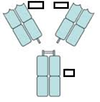Lecture 4 Adaptive Immunity - B Cell Development Flashcards
(24 cards)
How are endogenous and exogenous antigens presented?
Endogenous antigens presented with MHC II
Exogenous antigens presented with MHC I
Go through BCR Mechanism
BCR on B cell recognized native antigen
- antigen causes intracellular signalling and activation
- antigen internalized and processed into peptides
- peptide presented with MHC II to Helper T cell
What is the TCR?
Antigen presenting cell presents processed antigen, peptides, with either MHC I or MCH II to TCR
What are the regions and parts of a BCR? Both surface and antibody.


What are the regions and parts of the TCR?


What is the difference between the Surface Immunoglobulin and an antibody?
The antibody has no transmembrane region
How many antigen binding sites are present on a BCR and a TCR?
BCR has 2 antigen binding sites
TCR has 1 antigen binding sites
How do the different antigen binding sites differ in BCRs and TCRs?
The amino acid sequence of the polypeptide chains differ causing the antigen binding sites to be different
What are the parts of the immunoglobulin, Ig, structure? Ig are antibodies.


What is the Fab on an Ig?
Fab stands for Fragment of Antigen Binding
-this is the antigen binding site
What is the Fc on an Ig?
Part that is recognized by and interacts w/ rest of immune system
- doesn’t bind antigen
- phagocytic clls have FcR which bind part of antibody to phagocytoze
- adaptive and Innate interaction
- Different Isotypes= IgA, IgD, IgE, IgG, IgM
What are the different Ig Isotypes?


What are the regions of the Ig?

Each chain has a variable and constant region
-since each chain is a polypeptide chain that means there are genes for heavy and genes for light chains

What are the heavy chain gene segments and how many of each are there?
Variable Region
V1-41 - D1-23 - J1-6 - C
Constant Region
Cµ, Cd, Cg, Cα, or Cε
What are the light chain gene segments?
Variable region
V1-41 - J1-5
Constant region
Ck or Cl
Can’t have a gene for every pathogen out there, how do we address this issue?
Gene Rearrangement
- After hematopoiesis but before maturing the genes for heavy/light chains rearrange
- each mature lymphocyte has same Constant region
- each mature lymphocyte has one V, D, J gene in Variable region
What is the downside of gene rearrangement?
You end up making alt of antigen binding sites that don’t bind anything
- waste of energy
- do it enough times you get some working ones
How many possibilities are created by gene rearrangement (recombination)?
- 09 x 106 possibilities
- Heavy chain V-D-J recombination
- Light chain V-J recombination
- H-L=antigen binding site
What enzyme make recombination possible? What is its job?
Recombinase-activating gene (RAG) endonucleases
-RAG randomly cuts out V-D-J segments and sticks together
How do we create more than just 2x106 possibilities for different antigen binding sites?
Junctional diversity
- the enzymes Artemis and TdT add random nucleotides at junction sites between variable regions
- creates frameshift mutations leading to new possibilities
What if someone is born with a RAG deficiency?
They will have no antigen-binding site diversity resulting in an inability to fight infection
They will not be able to make BCRs or TCRs w/o RAG
-resulting in not functional B cells or T cells
Walk through B-cell development.
Progenitor B cell expresses heavychain first (D-J-V)
- to see if H-chain is functional its tested with surrogate light chain to form the Pre-BCR
- if non-functional it gets 2nd chance with 2nd allele
- if still non-functional then apoptosis
Light chain is expressed (K-λ)
- μ+K are expressed first
- if K is productive then expressed, if not 2nd K allele tried
- if K alleles unproductive then λ alleles tried
- if any are productive then they are kept or else apoptosis
Once functional Lymphocyte with IgM or IgD BCR is created then move on to negative selection
What is positive selection and negative selecion in B cell development?
Positive selection is when you have a functional productive allele it moves on to the next checkpoint
Negative selection is when a BCR binds to self antigens in bone marrow while maturing then it will be killed or undergo receptor editing
What is negative selection in detail?
Immature B cells with BCR in bone marrow interacts w/ cells/antigens
- If BCR encounters/interacts w/ antigen it will be self which is a sign of autoimmunity
- If B-cell binds antigen then either apoptosis or receptor editing
- receptor editing are genetic changes at the V-D-J level
- If not antigen binding then the B-cell will mature and move to secondary lymphoid tissue


